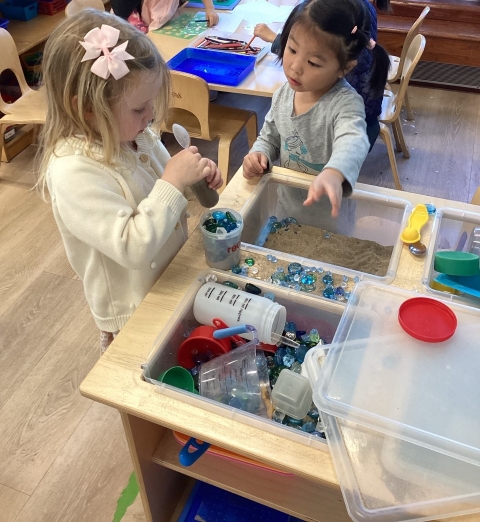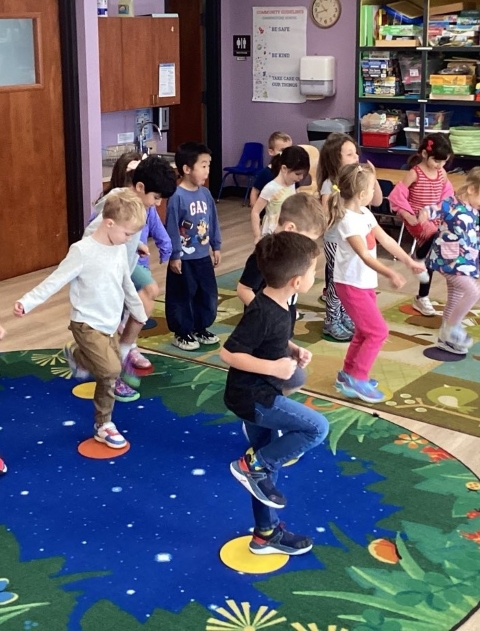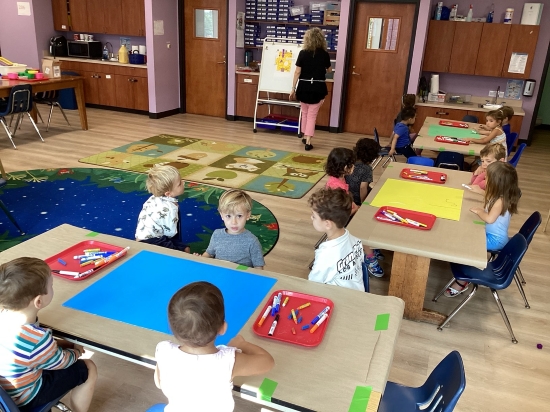“I used to be a preschool teacher in the city, so I had some expectations. My experience as a teacher, this age the most important way for them to learn is through play, dramatic play and any other type of play that shows what they’re interested in, and then they feed off of that. They’re not sitting them down at desks and drilling facts into them. Everything that they learn is through fun, through craft, through stories and through acting things out.”
-Lisa F.
Children learn about themselves and the world around them through interactions with peers and adults. At Cornerstone children are encouraged to pursue their own interests while being introduced to new concepts and materials using the Creative Curriculum®️.
The classroom community is a doorway to the global community as children gain experience with other cultures and traditions through stories, songs, and cooperative activities. We foster a sence of caring for others by partnering with local charitible organizations. Hands-on service projects such as food or clothing drives create meaning for our young learners.
Cornerstone is a place where all families are respected and the breadth of our collective experience is honored. Cornerstone teachers are skilled in using a play-based developmentally appropriate approach to early education. Classrooms and materials are invitations to play, as play is the how children learn.
Our experienced teachers scaffold individual student learning in academic areas while recognizing the importance of social, emotional, and physical development for future school success. With the support of Al’s Pals, a nationally recognized social-emotional learning curriculum for children ages 3 to 6, we help nurture these essential skills. Our low teacher-student ratio allows for small group and individual instruction throughout the school day, and we foster a strong home-school connection by inviting parents to join us in activities like reading stories, cooking, or sharing in other meaningful ways.
Literature comes to life through interactive songs and drama.
Children’s drawings become the foundation for storytelling and emerging writing.
Building structures with unit blocks fosters critical thinking about fractions and mathematical patterns.
Children learn to cope with real-world experiences through dramatic play and dress-up.
Immersion in music, art and movement provides a creative outlet for children’s self-expression.

Cornerstone School understands the importance of the arts in early childhood education. We have experts in their field both on staff and offering programs on site to ensure our students receive an educational experience that addresses all learning domains. Research proves the natural connection between STEM (Science Technology Engineering and Math) and the arts. During active learning critical thinking, problem-solving, and creativity promote these connections.
Through our Core Enrichment programs of Music and Art along with the many Elective Enrichment programs offered Cornerstone Students have the opportunity to experience the arts and technology during their school day.
Music class is held Mondays. Each class attends a 30 minute music class with our on-staff instructor, Stephen Agnew.

Children learn music in much the same way they learn language. Infants and toddlers learn to speak by listening and “playing” with language long before they learn any formal rules of language. Similarly, young children need ample time to “play” with the “language” of music before beginning any formal musical training. This is the purpose of Mr. Agnew’s music classes at Cornerstone School. Through research-based musical play within a song-based curriculum, children develop a strong foundation in the musical skills they will later need to be successful in formal music instruction.
Art class is held Weds and Thurs. All classes attend a 30 minute art class with our on-staff instructor, Karen Wright-Borkowski.

“Children are naturally curious. From the minute they gain control of their limbs, they work to put themselves out into the world to see how it all works. They explore, observe and imitate, trying to figure out how things operate and how to control themselves and their environments. This unrestricted exploration helps children form connections in their brain, it helps them learn—and it’s also fun.
Posted on January 22, 2015 by Kylie Rymanowicz, Michigan State University Extension
Art is a natural activity to support this free play in children. The freedom to manipulate different materials in an organic and unstructured way allows for exploration and experimentation. These artistic endeavors and self-directed explorations are not only fun, but educational as well. Art allows youth to practices a wide range of skills that are useful not only for life, but also for learning.
In addition to helping youth develop important skills, free expression is also good for overall health and well-being. Giving your child a creative outlet can help relieve stress and work through things happening in their lives. By encouraging artistic expression, you can help facilitate learning.
To create a fun, creative environment where a child can learn, grow and explore with confidence, at their own pace and with their own unique expression. Through teaching art fundamentals I look to broaden a child’s understanding of basic art concepts enhancing their creative experience within classroom. The children get to explore their creativity through a variety of projects that offer a lot of creative freedom. Throughout the year their artwork is displayed around the school creating a stimulating visual environment.